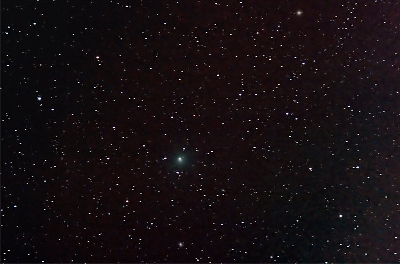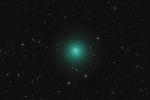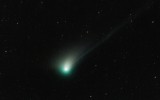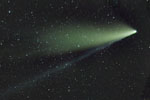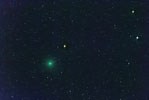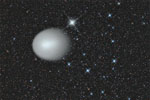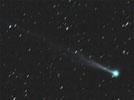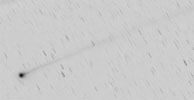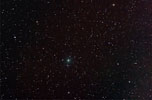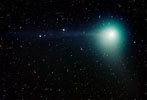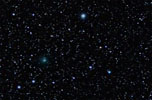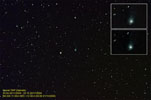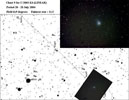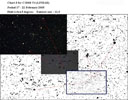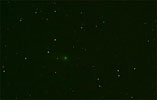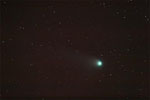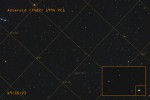Comet 9P/Tempel 1
This is a Short-period Jupiter Type comet with a period of 5.5 years. It was discovered in 1867 by the German astronomer Wilhelm Tempel.
The comet is notable for having been studied by two spacecraft. The first launched in 2005, called 'Deep Impact' was a space probe designed to study the comet's interior by releasing a 327 kg 'Smart Impactor' in the comet's path. It was the first mission to eject material from a comet and the impactor also sent high resolution images of the nucleus as the comet approached. The kinetic energy released in the collision was equivalent to 4.8 tonnes of TNT, creating a crater 100 meters wide and 30 meters deep.
A few minutes after the collision, the separate 'flyby' section of the space probe flew past at a distance of 500m, taking images and spectral measurements of the ejected material. Much of the it was found to fine dust.
Another space mission called 'Stardust' was used extended in 2011 to fly past the comet, so that better images could be made of the impact crater, which had been obscured by dust on the initial fly-by made by 'Deep Impact'.
For more info. see the Wikipedia entry.
Comets
Comets are small, but nonetheless significant visitors to the Solar system.
Typically they have a mass of about one-billionth × that of the Earth and their nucleus is just a few kilometres across. The nucleus is the core of the Comet and consists of a 'dirty snowball' of dust, water ice, carbon dioxide, ammonia and methane.
Comets are classified as either 'long-period' or 'short-period' depending on how often they approach Earth. Long-period comets appear at intervals of over 200 years and originate in the Oort Cloud, a spherical halo of icy bodies that lies about 40 AU's from the Sun. Short-period (or periodic) comets are thought to originate in the Kuiper Belt, a region of icy material that lies between the orbits of Neptune and Pluto. These are also sub-divided into two further categories, with Halley Type having periods of 20-200 years, and Jupiter Type with a period of less than 20 years.
As Comets approach the Sun, at about a ditance of about 3 AU's, they develop an extended region of gas and dust called the coma. When the Comet temperature reaches 215 K (-58° C) sublimation of water ice to vapour occurs. This material flows outward at approx 0.5 km/s and can extend 105 to 106 km in size. The coma then becomes visible from reflected sunlight, and may also emit radiation as the sunlight excites the gas.
If the Comet moves closer to the Sun, it may develop a large visible tail of up to 1 AU long. The tail actually consists of two tails. There is a gas tail or an ion tail which appears to point away from the Sun, and a dust tail which lies behind the Comet in the wake of it's path.
The gas tail (or ion tail) is due to the solar wind hitting the comet and contains a variery of molecular ions. Emission from CO+ is responsible for the blue colour of the tail which can extend 108 km.
The dust tail which trails behind the Comet is from material that is ejected by radiation pressure. These continue to follow a Kepelerian orbit and the dust tail can also be 107 km long.
Comets are brightest when they reach perihelion (their closest distance to the Sun), and they mostly traverse elliptical orbits, although their eccentricity and periodicity vary greatly.
Long-period comets are also of particular interest to scientists, as the Oort cloud is sufficiently far enough away to remain unaffected by heat from the Sun. They are therefore thought to be composed of original material from the formation of the solar nebula, whilst Short-period comets from the Kuiper belt provide information on the the formation of the outer Solar system.
For more info. see the Wikipedia entry on Comets.
